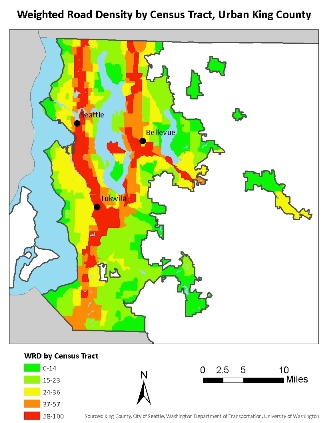
Fascinating, but not unexpected. A new analysis by University of Washington masters’ student Jill Schulte reveals that in urban King County, lower-income folks, as well as people of color, are more likely to live close to busy roads. And presumably, they’re more likely to suffer from poor air quality and other environmental harms as a result.
The findings about income and traffic density were exactly what I’d expect. Given a choice, most folks would rather not live along a major thoroughfare. But folks of limited means may not have the money to make a different choice—so I’m not surprised at all to find that low-income folks live in high-traffic places.
Yet what I found most troubling was that, even after controlling for incomes, race all by itself served as an independent predictor of living in dense traffic. That is, if you have two census tracts with the same income profiles, and with the same level of English proficiency, the one with a higher share of people of color will typically have heavier traffic.
I emailed with Jill Schulte, the report’s author, and she shared unpublished results showing that, even after holding English proficiency and income constant, a 10 percentage point increase in the percentage of residents of color was associated with a 2.8 point increase in the “weighted road density” score that the author used to measure proximity to heavy traffic.
And that means that neighborhoods with lots of people of color tend to have lots of traffic—even if the neighborhoods themselves are fairly well-off. That, in turn, suggests disparate health impacts on people of color; consider, for example, the new evidence that there’s a link between autism and exposure to traffic-related pollution in early life.
Yet there’s good news here too: Schulte’s analysis found that the relationships among race, income, and traffic density have grown weaker over time. In 2000, lower income folks were substantially more likely to live in high-traffic neighborhoods than in 2010; and the connection between race and traffic density has attenuated as well.
To me, this study highlights the importance of two closely interrelated tasks. First, as a society, we should be searching for ways to reduce the disparities in traffic impacts among different racial and ethnic groups—so you don’t face elevated risks just because you’re poor or a person of color. And second—and perhaps more importantly—we would be wise to find ways to reduce the health impacts of traffic for everyone. After all, it’ll count as little progress if the risks remain the same, but they’re just shifted to a different group of people.
Many thanks to King County for sharing the results of this study!


Comments are closed.